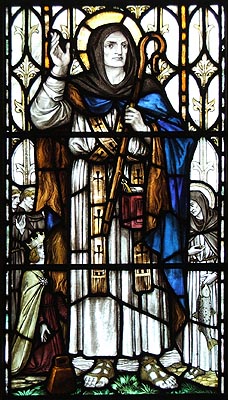 |
 |
|||
|
|
Prince Kentigern, was the fruit of an illicit liaison between King Owein of North Rheged and Princess Teniu of Gododdin. The otherwise unknown Garthwys is thought to be the place of his birth. Under his nickname of Mungo, he was brought up by St. Serf in Culross (Fife). Later he travelled to Strathclyde where he was ordained by an Irish missionary Bishop before continuing the work of St. Ninian in converting the locals around Glasgow. Here he founded an Episcopal See where he lived an austere life sleeping on a bed of stone, fasting and praying while standing naked in the Clyde. He was, however, persecuted by King Morken Mwynfawr (the Wealthy), and was obliged to flee. Settling in Wales, Kentigern first stayed with St. Dewi (David) but later moved north. Despite being hounded by King Maelgwn Gwynedd, he founded a monastery on the River Elwy. Here, at what became known as Llanelwy (St. Asaphs), he instructed St. Asaph in the ways of the Christian Church. Kentigern made seven pilgrimages to Rome, before eventually being called back to Strathclyde. King Morken had been succeeded by his brother, Riderch Hael (the Generous), the great ally of Kentigern's ageing grandfather. Riderch had already been converted to Christianity and made Kentigern the first Bishop of Strathclyde. He built churches and erected crosses far and wide, including Hoddam and Borthwick, and became firm friends with St. Columba. Kentigern died of shock after getting into a hot bath on Sunday 13th January AD 614. He was buried in his foundation, Glasgow Cathedral. Some say he lived to the age of 185. Though somewhere in his 60s is much more likely. The heraldic arms of Glasgow display a ring and a fish, commemorating an early miracle of this British saint. Records of St. Kentigern only seem to date back to the 12th century. However, he is generally considered historic.
|
|||
| © Nash Ford Publishing 2001. All Rights Reserved. | ||||





 St. Kentigern Garthwys
St. Kentigern Garthwys